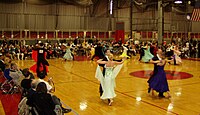
Photo from wikipedia
Resting energy expenditure (REE) is determined mainly by fat-free mass (FFM). FFM depends also on daily physical activity. REE normally decreases with increased age due to decreases in FFM and… Click to show full abstract
Resting energy expenditure (REE) is determined mainly by fat-free mass (FFM). FFM depends also on daily physical activity. REE normally decreases with increased age due to decreases in FFM and physical activity. Measuring REE is essential for estimating total energy expenditure. As such, there are a number of different equations in use to predict REE. In recent years, an increasing number of older adults continue to participate in competitive sports creating the surge of master athletes. It is currently unclear if these equations developed primarily for the general population are also valid for highly active, older master athletes. Therefore, we tested the validity of six commonly-used equations for predicting REE in master athletes. In conjunction with the World Masters Athletic Championship in Malaga, Spain, we measured REE in 113 master athletes by indirect calorimetry. The most commonly used equations to predict REE [Harris & Benedict (H&B), World Health Organization (WHO), Müller (MÜL), Müller-FFM (MÜL-FFM), Cunningham (CUN), and De Lorenzo (LOR)] were tested for their accuracies. The influences of age, sex, height, body weight, FFM, training hours per week, phase angle, ambient temperature, and athletic specialization on REE were determined. All estimated REEs for the general population differed significantly from the measured ones (H&B, WHO, MÜL, MÜL-FFM, CUN, all p < 0.005). The equation put forward by De Lorenzo provided the most accurate prediction of REE for master athletes, closely followed by FFM-based Cunningham’s equation. The accuracy of the remaining commonly-used prediction equations to estimate REE in master athletes are less accurate. Body weight (p < 0.001), FFM (p < 0.001), FM (p = 0.007), sex (p = 0.045) and interestingly temperature (p = 0.004) are the significant predictors of REE. We conclude that REE in master athletes is primarily determined by body composition and ambient temperature. Our study provides a first estimate of energy requirements for master athletes in order to cover adequately athletes’ energy and nutrient requirements to maintain their health status and physical performance.
Journal Title: Frontiers in Physiology
Year Published: 2021
Link to full text (if available)
Share on Social Media: Sign Up to like & get
recommendations!